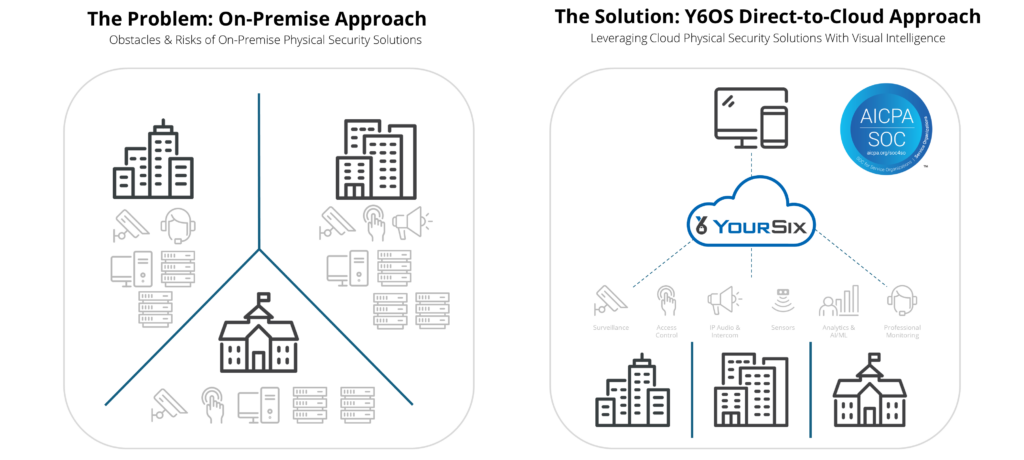Cloud vs On-Premise Solutions


In the world of physical security, on-premise solutions have long been the traditional choice for many organizations. However, as technology advances and operational needs evolve, the disadvantages of on-premise systems become increasingly apparent. From manual updates to high bandwidth costs, these systems come with hidden costs and challenges that can impact both security and efficiency. For additional information please view Total Cost of Ownership Comparison: Cloud vs On-premise.
Manual Feature Updates
-
- The Challenge: On-premise systems often require manual updates to add new features or improve existing ones. This process can be time-consuming and labor-intensive, requiring IT staff to actively manage updates and ensure compatibility.
- Implications:
- Inconsistent Features: Manual updates can lead to inconsistencies in feature availability and performance across different systems.
- Increased Workload: IT teams must dedicate time and resources to manage updates, diverting attention from other critical tasks.
Unpatched Vulnerabilities
-
- The Challenge: On-premise systems can be vulnerable to security threats if vulnerabilities are not promptly patched. Unlike cloud solutions with automatic updates, on-premise systems often lack a streamlined patching process.
- Implications:
- Increased Risk: Unpatched vulnerabilities can expose the system to cyberattacks and data breaches.
- Delayed Response: Identifying and addressing vulnerabilities requires manual intervention, which can delay response times.
Limited Scalability
- The Challenge: Scaling an on-premise solution involves significant investments in additional hardware and infrastructure. This can be a complex and costly process, especially as the number of devices or users grows.
- Implications:
- High Costs: Expanding an on-premise system requires purchasing new hardware, which can be expensive.
- Complex Setup: Additional hardware means more time and effort spent on installation and configuration.
Network Hardware Vulnerabilities
- The Challenge: On-premise systems rely heavily on network hardware, which is often a common target for attacks and a potential point of failure.
- Implications:
- Security Risks: Network hardware can be vulnerable to cyberattacks, leading to potential breaches.
- System Downtime: Hardware failures can disrupt the entire system, impacting operational continuity.
High Bandwidth Costs
- The Challenge: On-premise systems can incur high bandwidth costs, especially when handling large volumes of data or video feeds.
- Implications:
- Increased Expenses: High bandwidth usage translates to higher costs, which can strain budgets.
- Limited Efficiency: Inefficient bandwidth management can impact system performance and reliability.
No Notifications if System Goes Offline
- The Challenge: On-premise solutions often lack automated notifications or alerts if the system goes offline or encounters issues.
- Implications:
- Delayed Response: Without notifications, issues may go unnoticed for extended periods, leading to potential operational disruptions.
- Increased Risk: Lack of real-time alerts can delay response to security threats or system failures.
Rapid Aging of Systems
- The Challenge: On-premise systems can become outdated quickly due to rapid advancements in technology and evolving security threats.
- Implications:
- Obsolete Hardware: Systems may become obsolete faster, requiring costly upgrades or replacements.
- Increased Maintenance: Older systems may require more frequent maintenance and repairs.
Conclusion
On-premise solutions, while once the standard choice, come with a range of disadvantages that can impact both operational efficiency and security. From the challenges of manual updates and unpatched vulnerabilities to the high costs and limited scalability, these systems present hidden costs that can affect your organization’s overall performance.
As you evaluate your options for physical security, consider these disadvantages and how they might influence your decision. Cloud-based solutions offer a modern alternative that addresses many of these issues, providing automatic updates, enhanced scalability, and reduced costs. By understanding the limitations of on-premise systems, you can make more informed choices and ensure that your security solution meets your organization’s needs effectively and efficiently.
On-Premise Total Cost of Ownership Factors
Cloud vs On-Premise TCO Comparison
